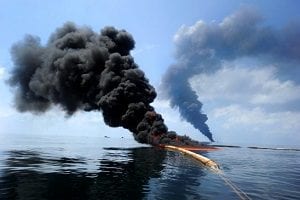Research Sheds New Light on BP Oil Spill

Dark clouds of smoke and fire emerge as oil burns in the Gulf of Mexico following the April 20 explosion on the Deepwater Horizon. U.S. Navy photo by Specialist 2nd Class Justin Stumberg
Scientists have been studying the effects of the Deepwater Horizon oil spill on the Gulf of Mexico for years, but research by UCF professors – and a $1.5 million grant that funds their work – could shed new light on undetected pollution lurking beneath the seafloor.
The catastrophic blowout of the Deepwater Horizon drilling rig in 2010 caused the largest oil spill in U.S. history, releasing an estimated 206 million gallons of crude oil into the gulf before it was capped 87 days later.
While visible evidence of the spill is largely gone, evidence of toxic compounds carried in the oil lingers. Some of those chemicals, known as polycyclic aromatic hydrocarbons (PAHs), are classified as hazardous because they can cause genetic mutations and cancer in organisms that come into contact with them.
There are hundreds of PAHs present in the environment, but the U.S. Environmental Protection Agency tracks only 16 of them, the ones the agency lists as “priority pollutants.” Andres Campiglia, Ph.D., UCF chemistry professor, says that many of the PAHs not included in the EPA list are actually more toxic than the ones being tracked.
“It is possible that many of those pollutants still remain in the gulf, and the true picture of the spill’s environmental impact and effect on the ecosystem – and human health – is unknown,” Campiglia said.
So why are those potentially more dangerous PAHs not routinely monitored in the environment? According to Campiglia, one of the main reasons is the lack of reliable analytical methods.
Campiglia, thanks to research he began a decade ago, now has the ability to do what other researchers couldn’t: detect these “forgotten PAHs.” The Gulf of Mexico Research Initiative recently awarded Campiglia a $1.5 million grant to track down the environmental fate of those PAHs.
Over the next three years, Campiglia, the principal investigator, along with fellow UCF Department of Chemistry faculty members, James Harper, Ph.D., and Fernando Uribe-Romo, Ph.D., will focus on PAHs with a higher molecular weight than those currently monitored. Because of heavier weight, these PAHs can sink into the ocean bottom and remain longer in the environment than the ones monitored by the EPA. Some of these heavier PAHs are known to cause genetic mutations.
To positively identify those compounds, they’ll use methodology and instrumentation Campiglia developed at UCF.
They’ll use a pulsed laser to cause the samples to emit radiation in the form of fluorescence and/or phosphorescence. That will allow the researchers to measure the samples’ spectral features – for example, the intensity of radiation as a function of wavelength – as well as the time it takes for the emitted radiation to fade. Both results are unique for each type of PAH, so the combined information provides double confirmation.
“For each one of these compounds, there is a spectral fingerprint and a unique lifetime decay,” Campiglia said. “It gives us unambiguous identification even if the compound is at much lower concentrations than their chemically and closely related siblings.”
The scientists will also collaborate with other gulf spill researchers to track down specific PAHs and better understand their environmental fate in the Gulf of Mexico.
To read original story on UCF Today, click here.
